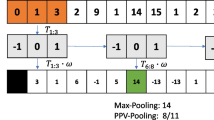Abstract
More and more data is gathered every day and time series are a major part of it. Due to the usefulness of this type of data, it is analyzed in many application domains. While there already exists a broad variety of methods for this task, there is still a lack of approaches that address new requirements brought up by large-scale time series data like cross-domain usage or compensation of missing data. In this paper, we address these issues, by presenting novel approaches for generating and forecasting large-scale time series data.







Similar content being viewed by others
References
Aldrin M, Damsleth E (1989) Forecasting non-seasonal time series with missing observations. J Forecast 8(2):97–116
Bilbao J, de Miguel AH, Kambezidis HD (2002) Air temperature model evaluation in the north mediterranean belt area. J Appl Meteorol 41(8):872–884
Box GEP, Jenkins GM, Reinsel GC (2008) Time series analysis: forecasting and control. Wiley, Oxford
Chatfield C (2000) Time-series forecasting. Chapman & Hall, CRC, New York. ISBN: 9781584880639
Cleveland RB, Cleveland WS, McRae JE, Terpenning I (1990) STL: a seasonal-trend decomposition procedure based on loess. J Off Stat 6(1):3–73
Cuddihy MA, Drummond JB Jr., Bourquin DJ (1994) Vehicle crash data generator. US patent/grant: US5608629A
Forestier G, Petitjean F, Dau HA, Webb GI, Keogh E (2017) Generating synthetic time series to augment sparse datasets. Proc ICDM. https://doi.org/10.1109/ICDM.2017.106
Hartmann C, Hahmann M, Habich D, Lehner W (2017) CSAR: the cross-sectional Autoregression model. Proc DSAA. https://doi.org/10.1109/DSAA.2017.27
Hartmann C, Hahmann M, Rosenthal F, Lehner W (2015) Exploiting big data in time series forecasting: a cross-sectional approach. Proc DSAA. https://doi.org/10.1109/DSAA.2015.7344786
Hyndman RJ, Khandakar Y (2008) Automatic time series for forecasting: the forecast package for R. J Stat Softw. https://doi.org/10.18637/jss.v027.i03
Iftikhar N, Liu X, Danalachi S, Nordbjerg FE, Vollesen JH (2017) A Scalable Smart Meter Data Generator Using Spark. OTM. https://doi.org/10.1007/978-3-319-69462-7_2
IJCAI (2017) IJCAI 2017 – Data Mining Contest. http://tb.am/s0a3o. Accessed 08.02.
Jones DI, Lorenz MH (1986) An application of a Markov chain noise model to wind generator simulation. Math Comput Simul 28(5):391–402
Kaminsky FC, Kirchhoff RH, Syu CY, Manwell JF (1991) A comparison of alternative approaches for the synthetic generation of a wind speed time series. J Sol Energy Eng 113(4):280–289
Kang Y, Hyndman RJ, Smith-Miles K (2017) Visualising forecasting algorithm performance using time series instance spaces. Int J Forecast 33(2):345–358
Kegel L, Hahmann M, Lehner W (2017) Feature-driven time series generation. Proc 29th GvDB Workshop, p. 54–59
Kegel L, Hahmann M, Lehner W (2017) Generating what-if scenarios for time series data. Proc SSDB. https://doi.org/10.1145/3085504.3085507
Kegel L, Hahmann M, Lehner W (2018) Feature-based comparison and generation of time series. Prof SSDBM. https://doi.org/10.1145/3221269.3221293
Makridakis S, Hibon M (2000) The M3-Competition: results, conclusions and implications. Int J Forecast 16(4):451–476
Müller H, Haberlandt U (2015) Temporal rainfall disaggregation with a cascade model: from single-station disaggregation to spatial rainfall. J Hydrol Eng. https://doi.org/10.1061/(ASCE)HE.1943-5584.0001195
Neupane B, Pedersen TB, Thiesson B (2014) Towards flexibility detection in device-level energy consumption. Workshop Proc ECML PKDD. https://doi.org/10.1007/978-3-319-13290-7_1
van Paassen AHC, Luo QX (2002) Weather data generator to study climate change on buildings. Build Serv Eng Res Technol 23(4):251–258
Pesch T, Schröders S, Allelein HJ, Hake JF (2015) A new Markov-chain-related statistical approach for modelling synthetic wind power time series. New J Phys. https://doi.org/10.1088/1367-2630/17/5/055001
R Core Team (2014) R: A Language and Environment for Statistical Computing. R Foundation for Statistical Computing, Vienna, Austria
Rahm E, Nagel WE, Peukert E, Jaekel R, Gaertner F, Stadler PF, Wiegreffe D, Zeckzer D, Lehner W (2019) Competence center ScaDS Dresden/leipzig: overview and selected research activities. Datenbank Spektrum 19(1)
Schaffner J, Januschowski T (2013) Realistic tenant traces for enterprise DBaaS. Work Proc ICDE. https://doi.org/10.1109/ICDEW.2013.6547423
The Commission for Energy Regulation (2015) CER smart metering project. http://www.ucd.ie/issda/data/commissionforenergyregulationcer/. Accessed 18.12.2017
VDE e.V. (2011) Messwesen Strom (Metering Code); VDE-AR‑N 4400
Funding
This work was funded by the German Federal Ministry of Education and Research within the project Competence Center for Scalable Data Services and Solutions Phase 1—ScaDS Dresden/Leipzig (BMBF 01IS14014A).
Author information
Authors and Affiliations
Corresponding author
Rights and permissions
About this article
Cite this article
Hahmann, M., Hartmann, C., Kegel, L. et al. Large-Scale Time Series Analytics. Datenbank Spektrum 19, 17–29 (2019). https://doi.org/10.1007/s13222-018-00304-5
Received:
Accepted:
Published:
Issue Date:
DOI: https://doi.org/10.1007/s13222-018-00304-5




